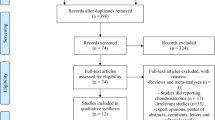Abstract
Objective
To assess the value of [18F]fluoro-2-deoxy-d-glucose positron emission tomography (18FDG-PET) in defining aggressive cartilage neoplasms, particularly those with problematic or borderline histologic, imaging and clinical characteristics.
Design and patients
From 2000 to 2003, 29 cartilage lesions were studied with whole-body 18FDG-PET scans (Siemens Ecat Exact, Knoxville, Tenn.). Analyses of data in 20 females and nine males, 11–85 years old, were based on maximum standard uptake values (SUVs) in regions of interest (ROIs) on axial 3.37 mm thick, 3×3 pixel images. A statistically significant maximum SUV cutoff of 2.0 was used to distinguish benign from malignant cartilage neoplasms and correlated with the postoperative histopathologic findings.
Results
In 26 operated cases the overall sensitivity of whole-body 18FDG-PET in separating benign and malignant lesions was 90.9% (10/11), specificity 100% (18/18) and accuracy 96.6%.
Conclusions
Whole-body 18FDG-PET is a valuable adjunct in identifying primary, recurrent and metastatic cartilage malignancies. It supplements classic histology and morphologic imaging with functional data which may facilitate management in individual cases.









Similar content being viewed by others
References
Evans HL, Ayala AG, Romsdah MM. Prognostic factors in chondrosarcoma of bone. Cancer 1977; 40:818–831.
Mankin HJ, Lange TA, Spanier SS. The hazards of biopsy in patients with malignant primary bone and soft tissue tumors J Bone Joint Surg Am 1982; 64:1121–1127.
Rosenthal DJ, Schiller AL, Mankin HJ. Chondrosarcoma: correlation of radiological and histological grade. Radiology 1984; 150:21–26.
Unni K. Dahlin’s bone tumors: general aspects and data on 11,087 cases, 5th edn. Philadelphia: Lippincott-Raven, 1996:143–183.
Som P, Atkins HL, Bandaypadhyay D, et al. A fluorinated glucose analog, 2-fluoro-2-glucose (F18): nontoxic tracer for rapid tumor detection. J Nucl Med 1980; 21:670–675.
Messa C, Landoni C, Pozzaato C, et al. Is there a role for FDG-PET in the diagnosis of musculoskeletal neoplasms? J Nucl Med 2000; 41:170–317[AU: PLEASE CHECK PAGE NOS.].
Cook G, Fogelman I. The role of positron emission tomography in skeletal disease. Semin Nucl Med 2001; 31:50–61.
Kole AC, Nieweg OE, Hoekstra HJ, et al. F18 assessment of glucose metabolism in bone tumors. J Nucl Med 1998; 39:810–815.
Kern KA, Brunetti A, Norton JA, et al. Metabolic imaging of human extremity musculoskeletal tumors by PET. J Nucl Med 1998; 29:181–186.
Dehdashti FD, Siegel GA, Griffeth LK, et al. Benign vs malignant intraosseous lesions: discrimination by means of PET with 2-(F18)-fluoro-2-deoxy-d-glucose. Radiology 1996; 200:243–247.
Eary JF, Conrad E, Bruckner JD, et al Quantitative (F18) fluorodeoxyglucose positron emission tomography in pretreatment and grading of sarcoma. Clin Cancer Res 1998; 4:1215–1220.
Brenner W, Conrad EU, Eary JF. FDG PET imaging for grading and prediction of outcome in chondrosarcoma patients. Eur J Nucl Med Mol Imaging 2004; 31:189–195.
Schulte M, Brecht-Krauss D, Heymer B, et al. Grading of tumors and tumorlike lesions of bone: evaluation by FDG PET. J Nucl Med 2000; 41:1695–1701.
Gilkey FW, Moser RP. The biology of cartilage. In: Moser RP, ed. Cartilaginous tumors of the skeleton. Philadelphia: Hanley and Belfus, 1990:1–7.
Feldman F, VanHeertum R, Manoj C.18FDG PET scanning of benign and malignant musculoskeletal lesions. Skeletal Radiol 2003; 32:201–208.
Aoki J, Watanabe H, Shinozaki T, et al. FDG PET in differential diagnosis and grading of chondrosarcomas. J Comput Assist Tomogr 1999; 23:603–608.
Aoki J, Watanabe H, Shinozaki T, et al. FDG PET of primary benign and malignant bone tumors: standardized uptake value in 52 lesions. Radiology 2001; 219:774–777.
Arsos G, Venizelos I, Karatzas N, et al. Low grade chondrosarcomas: a difficult target for radionuclide imaging. Eur J Radiol 2002; 43:66–72.
Hammacher K, Coenen HH, Stocklin G. Efficient stereospecific synthesis of no-carrier-added 2-[18F]fluoro-2-deoxy-d-glucose using aminopolyether supported nucleophilic substitution. J Nucl Med 1986; 27:235–238.
Pritchard D, Unni K. Chondrosarcoma. International Skeletal Society closed meeting syllabus, Stockholm, Sweden, Aug 25, 1992.
Personal communication, Prof. G. Steiner, Chief of Pathology, Orthopedic Institute, NYC.
Bredella M, Caputo GR, Steinbach LS. Value of PDG positron imaging in conjunction with MRI for evaluating therapy response in patients with musculoskeletal sarcomas. AJR Am J Roentgenol 2002; 179:1145–1150.
Franzius C, Sciuk, J, Brinkschmidt C, et al. Evaluation of chemo-therapy response in primary bone tumors with F-18 FDG positron emission tomography compared with histologically assessed tumor necrosis. Clin Nucl Med 2000; 25:874–881.
Franzius C, Daldrup-Link, H, Wagner-Bohn A, et al. FDG-PET for detection of recurrences from malignant primary bone tumors: comparison with conventional imaging. Ann Oncol 2002; 13:157–160.
Zasadny KR, Wahl RL. Standardized uptake values in normal tissues at PET with 2-(F18) fluoro-2-deoxy-d-glucose. Variations with body weight and a method for correction. Radiology 1993; 89:847–850.
Kubota R, Yamada S, Kubota K, et al. Intratumoral distribution of fluorine 18-fluorodeoxyglucose in vivo: high accumulation in macrophages and granulation tissue studied by microautoradiography. J Nucl Med 1992; 33:1972–1980.
Guhlmann A, Brechy-Krauss D, Suger G, et al. Chronic osteomyelitis: detection with FDG PET and correlation with histopathologic findings. Radiology 1998; 206:749–754.
Author information
Authors and Affiliations
Corresponding author
Rights and permissions
About this article
Cite this article
Feldman, F., Heertum, R.V., Saxena, C. et al. 18FDG-PET applications for cartilage neoplasms. Skeletal Radiol 34, 367–374 (2005). https://doi.org/10.1007/s00256-005-0894-y
Received:
Revised:
Accepted:
Published:
Issue Date:
DOI: https://doi.org/10.1007/s00256-005-0894-y




